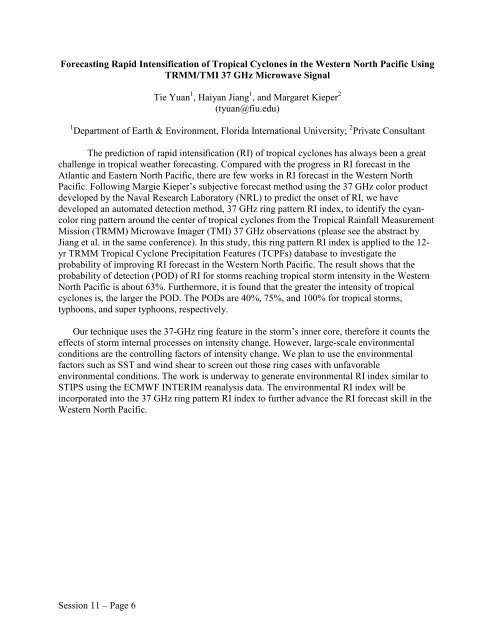65th IHC Booklet/Program (pdf - 4.9MB) - Office of the Federal ...
65th IHC Booklet/Program (pdf - 4.9MB) - Office of the Federal ...
65th IHC Booklet/Program (pdf - 4.9MB) - Office of the Federal ...
You also want an ePaper? Increase the reach of your titles
YUMPU automatically turns print PDFs into web optimized ePapers that Google loves.
Forecasting Rapid Intensification <strong>of</strong> Tropical Cyclones in <strong>the</strong> Western North Pacific Using<br />
TRMM/TMI 37 GHz Microwave Signal<br />
Tie Yuan 1 , Haiyan Jiang 1 , and Margaret Kieper 2<br />
(tyuan@fiu.edu)<br />
1 Department <strong>of</strong> Earth & Environment, Florida International University; 2 Private Consultant<br />
The prediction <strong>of</strong> rapid intensification (RI) <strong>of</strong> tropical cyclones has always been a great<br />
challenge in tropical wea<strong>the</strong>r forecasting. Compared with <strong>the</strong> progress in RI forecast in <strong>the</strong><br />
Atlantic and Eastern North Pacific, <strong>the</strong>re are few works in RI forecast in <strong>the</strong> Western North<br />
Pacific. Following Margie Kieper’s subjective forecast method using <strong>the</strong> 37 GHz color product<br />
developed by <strong>the</strong> Naval Research Laboratory (NRL) to predict <strong>the</strong> onset <strong>of</strong> RI, we have<br />
developed an automated detection method, 37 GHz ring pattern RI index, to identify <strong>the</strong> cyancolor<br />
ring pattern around <strong>the</strong> center <strong>of</strong> tropical cyclones from <strong>the</strong> Tropical Rainfall Measurement<br />
Mission (TRMM) Microwave Imager (TMI) 37 GHz observations (please see <strong>the</strong> abstract by<br />
Jiang et al. in <strong>the</strong> same conference). In this study, this ring pattern RI index is applied to <strong>the</strong> 12-<br />
yr TRMM Tropical Cyclone Precipitation Features (TCPFs) database to investigate <strong>the</strong><br />
probability <strong>of</strong> improving RI forecast in <strong>the</strong> Western North Pacific. The result shows that <strong>the</strong><br />
probability <strong>of</strong> detection (POD) <strong>of</strong> RI for storms reaching tropical storm intensity in <strong>the</strong> Western<br />
North Pacific is about 63%. Fur<strong>the</strong>rmore, it is found that <strong>the</strong> greater <strong>the</strong> intensity <strong>of</strong> tropical<br />
cyclones is, <strong>the</strong> larger <strong>the</strong> POD. The PODs are 40%, 75%, and 100% for tropical storms,<br />
typhoons, and super typhoons, respectively.<br />
Our technique uses <strong>the</strong> 37-GHz ring feature in <strong>the</strong> storm’s inner core, <strong>the</strong>refore it counts <strong>the</strong><br />
effects <strong>of</strong> storm internal processes on intensity change. However, large-scale environmental<br />
conditions are <strong>the</strong> controlling factors <strong>of</strong> intensity change. We plan to use <strong>the</strong> environmental<br />
factors such as SST and wind shear to screen out those ring cases with unfavorable<br />
environmental conditions. The work is underway to generate environmental RI index similar to<br />
STIPS using <strong>the</strong> ECMWF INTERIM reanalysis data. The environmental RI index will be<br />
incorporated into <strong>the</strong> 37 GHz ring pattern RI index to fur<strong>the</strong>r advance <strong>the</strong> RI forecast skill in <strong>the</strong><br />
Western North Pacific.<br />
Session 11 – Page 6
















